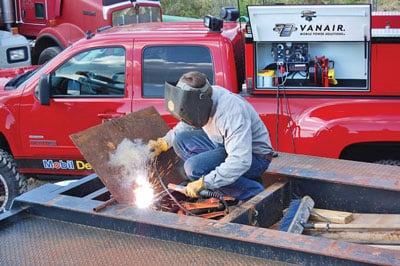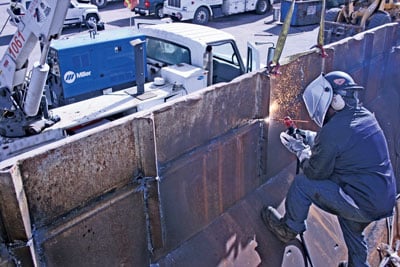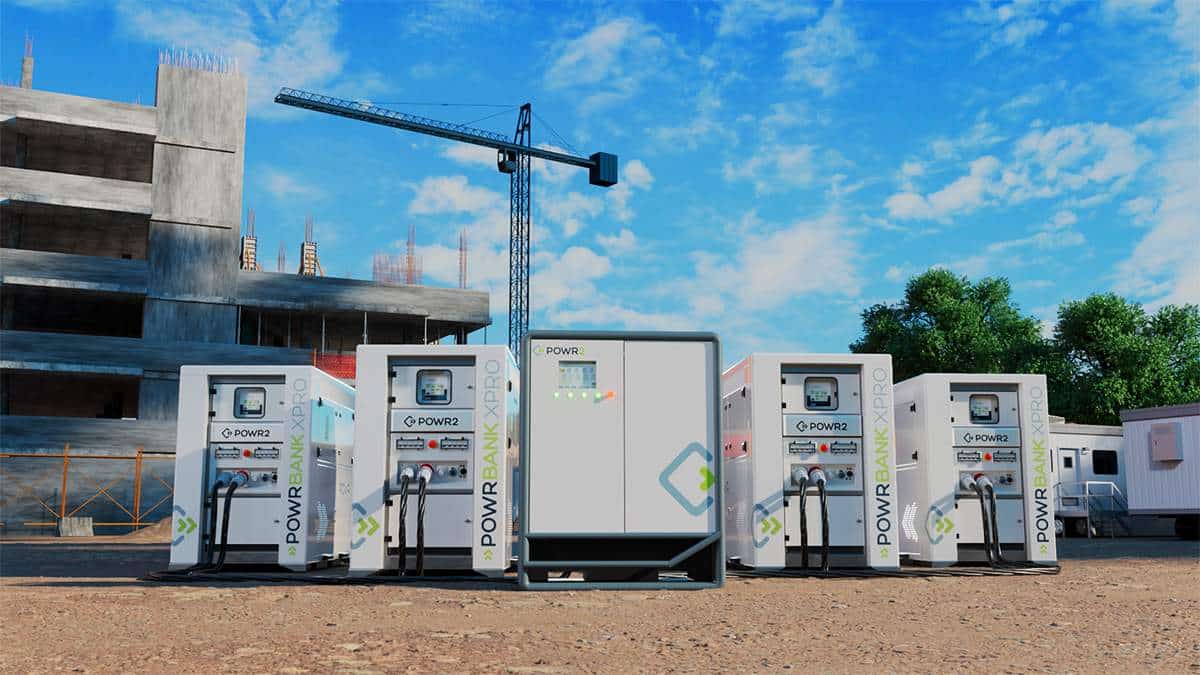Welder/Generator/Air Compressor Combo Units Are Evolving
Years ago, it was big news when a manufacturer added an air compressor to a welder/generator. Today, OEMs are engaged in an arms race to outfit their equipment with as much functionality as possible. Stakes have been raised with battery chargers, jump starters and hydraulics. It makes sense: Whether your work is dedicated to service and repair or you’re a tradesman with a “power box” on the back of your truck to handle whatever repairs or challenges come your way — new equipment on the market today increases your capacity for work without expanding your footprint. And it’s now more efficient than ever.
“The multi-functional capabilities [with these combination units] allows for convenience, more bed space, lower cost output, lower fuel consumption and greater productivity — all features that are critical to our customers,” says Chris Sloan, marketing manager with Vanair.
A Focus on Efficiency

Auxiliary power ranks near the top of a welder/generator owner’s most important features. It gives contractors the versatility to operate lots of hand tools.
Arguably the strongest value proposition for combination units is lower owning and operating costs. A combination unit features a single engine to maintain and costs less than if you were to buy and maintain separate units — and the single unit takes up less space. There are now even more extensive all-in-one options on the market, such as the Air N Arc I-300 from Vanair, that includes a welder, generator, air compressor, hydraulic pump, battery charger and jump starter in a single footprint. Miller Electric Mfg. Co. has further extended its larger, low-speed diesel line to feature dual operating systems that run completely independent of each other to create two distinct workstations — effectively doubling output without doubling space.
Even with the recent drop in fuel prices, fuel efficiency remains a top purchase driver for anyone running engine-driven equipment. It has as much to do with productivity as it does cost savings.
“The thing that comes to mind right off the bat is fuel consumption — the ease of having longer run times without the need for refueling,” says Christopher Cramer, owner of Metal Connection LLC in Oshkosh, Wis. “It doesn’t take long to fuel up, but it is a hassle.”
“Greater fuel efficiency equates to longer runtimes for welding operators on the job, which can help increase productivity,” says Travis Purgett, product manager with Miller. “Less time spent on refueling means more time doing other value-added activities.”
OEMs have engineered this equipment to be more fuel efficient. The first machines with electronic fuel injection (EFI) were introduced about five years ago, and most major manufacturers, including Miller, Lincoln Electric and Vanair, have that option available. EFI offers numerous benefits, including no choke, better starting in cold environments and reduced fuel deterioration — but the biggest benefit is an optimized blending of air and fuel for efficient combustion/reduced fuel use. More advanced fuel management technology, however, has further revolutionized the efficiency of these machines. Miller, for instance, has implemented a number of speed-governing technologies that allow the machines to burn only as much fuel as is needed for the job at hand.
“A common application is welding a 1/8-in. 7018 stick electrode,” says Purgett. “With speed governing technology, welding operators can complete this type of welding all day and never have the machine come out of idle. Any stick, TIG or MIG application that runs at 150 amps or lower can be completed at idle, or 2,400 rpm. A machine with speed-regulating technology can save about $460 per year in fuel costs compared to a machine without it.”
Welding

Welder/generators can be mounted many ways in work trucks and remote control functionality adds further flexibility.
A welder/generator combo provides contractors with the capability of running most welding processes. Stick welding remains the most common. Wire processes — specifically self-shielded flux cored welding — are also popular in field applications. Both stick and self-shielded flux cored are preferred because they provide their own weld protection (wire processes that require gas shielding need extra equipment and are subject to wind blowing away the shielding). All welder/generators can perform stick welding. Wire processes require a constant voltage (CV) output to work optimally with wire feeders or spool guns. These machines are capable of TIG welding, but it is generally preferred to TIG weld with a dedicated, inverter-based machine (which can be run off of the generator power of some of the higher-output welder/generators).
“Understand what the output requirements are for the wires you use and the output capabilities of the units you have or are considering,” says Purgett. “Typical-use duty cycle is higher when wire welding than when stick welding due to the continuous feed capability of wire versus having to replace the stick electrode when it burns down.”
One of the general concerns about welder/generators is degradation of the welding arc when another tool is engaged off of the machine’s auxiliary power. Miller and Vanair both tout solutions that eliminate the problem. Miller offers machines with two separate generators (one for welding and three phase, one for one phase) in its large frame, low-speed diesel line; and a generator with separate windings for weld and auxiliary power in its Trailblazer line. Vanair features two separate independent generators throughout its product line, which allows for dual functionality such as welding and auxiliary lighting. With this technology, degradation is less of a concern.
“Our systems have very sophisticated and reliable engineering and computer logic within them,” says Sloan. “This helps in determining horsepower loads when engaging multiple product features.”
Auxiliary Power/Battery Charger/Jump Starter
Most hand tools on jobsites can be operated at the lower end of a generator’s capacity. Larger tools and equipment, however, require greater outputs — and that’s where it’s important to know the difference between peak and continuous power — and how it relates to your tools. Peak wattage correlates to startup power — the energy required to get the tool cranking. Continuous watts refer to the power required to run the tool.
For basic jobsite tools, Miller has introduced an optional technology on select models called Excel Power that provides contractors 2,400 watts or pure 120-V, 60-hertz generator power completely separate from the machine’s standard generator. This allows the user to operate tools below that capacity without the machine ever leaving idle. Cramer — whose business focuses on mobile fabrication and site repair — pays close attention to auxiliary power when specifying welder/generators. The high end of that demand revolves around plasma cutters.
“Having the auxiliary power to run the larger plasma cutters is important,” says Cramer. “12,000 to 15,000 watts is ideal. With my Trailblazer 302 AirPak, I can run a [rated 60-amp] plasma cutter at 50 out of 60 amps. You can run it wide open at 60 amps, but if you’re running it and it’s warm out, and you get heat build up, I can run about 50 amps, which gives you 1/2-in., maybe 5/8-in. cutting capacity.”
Most OEMs in this space now offer battery charger/jump starter capability, which is important to everyone in construction-related industries, as most operate a fleet of trucks or equipment. It’s just one more way these combo units have become more useful. “Depending on the product, Vanair features a 12-V charge and or a 12V/24-V boost. This enables the customer to jump start their truck’s engine while our auxiliary power can maintain the truck’s own battery and can operate work and emergency lights while the truck engine is off saving on fuel and operating costs,” adds Sloan.
Air Compressor/Hydraulics
Air compressor functionality varies based on make and model, but most feature more than enough cfm/psi at 100 percent duty cycle to handle basic air tools: grinders, shears, impact wrenches, etc. Air needs will increase as you begin using larger industrial tools or consider carbon arc gouging.
Hydraulics are relatively new to this product category. Miller came to market with its EnPak product line, which did not feature a built-in welder, but did include hydraulic functionality for powering service truck cranes, and a Hydraulic Tool Control (HTC) for operating independent hydraulic tools. Vanair’s I-300 features a built-in welder with a variable displacement hydraulic piston pump, compatible with both open center and closed center systems. For Purgett, selecting the right machine comes down to a practical understanding of spec demands and future ambitions.
“Understand your needs, present and future,” says Purgett. “If you are planning to purchase a welder/generator for the first time, be sure to understand the auxiliary power, weld and compressed air requirements. Consider what your needs will be one, two and even five years in the future.”
That advice goes for both specs/capacity and the capability of adding more tools and capabilities to your skill set. For Cramer, he sees the investment in greater functionality as a platform for greater profitability. “For an additional $5,000 investment, your ROI is very quick.”
Bill Elverman is a contributing writer to Compact Equipment.





